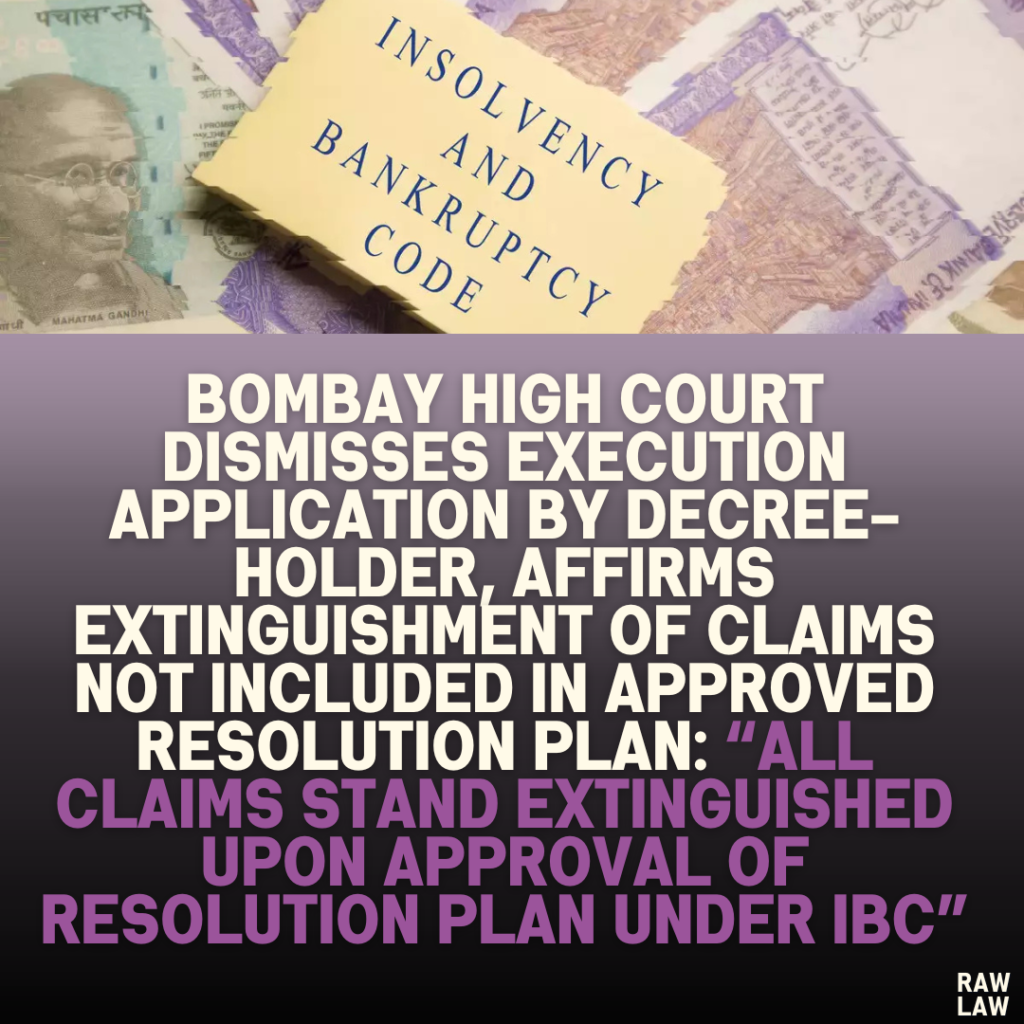Court’s Decision
The Bombay High Court, presided over by Justice Abhay Ahuja, dismissed the Execution Application filed by the applicant. The court emphasized that claims not forming part of an approved Resolution Plan under the Insolvency and Bankruptcy Code, 2016 (IBC), stand extinguished and cannot be enforced through execution proceedings.
Key Observation: “Once a Resolution Plan has been approved by the Adjudicating Authority, all claims not included in it stand extinguished, and no person is entitled to initiate or continue proceedings in respect of such claims.”
Facts
- Background of the Dispute:
- The applicant had obtained a decree on December 17, 2012, from the Bombay High Court for recovery of dues arising from services rendered to the respondent.
- The services involved excavation, earthworks, and reclamation at the respondent’s project site.
- Insolvency Proceedings:
- On March 5, 2020, the NCLT approved a Resolution Plan for the respondent under the IBC.
- Under the plan, the applicant was classified as an “operational creditor” and was entitled to NIL payment.
- Execution Application:
- Despite the approval of the Resolution Plan, the applicant sought to execute the decree, arguing that as a decree-holder, their claim was distinct and should not have been extinguished.
Issues
- Whether the applicant, as a decree-holder, could continue execution proceedings despite the Resolution Plan’s approval.
- Whether the claims extinguished under the approved Resolution Plan could still be enforced.
Petitioner’s Arguments
- Separate Classification of Decree-Holder:
- The applicant argued that a decree-holder constitutes a distinct class of creditor under Section 3(10) of the IBC and should be treated differently from operational creditors.
- Non-Extinguishment of Claims:
- The Resolution Plan did not specifically address or extinguish the claim of the decree-holder. Without clarity on the status of the claim, execution proceedings should be allowed.
- Requirement to Peruse the Resolution Plan:
- The applicant insisted that the court should examine the Resolution Plan to ascertain whether the decree-holder’s claim had been considered or rejected.
Respondent’s Arguments
- Finality of the Resolution Plan:
- The respondent contended that the Resolution Plan, approved by the NCLT and upheld by the National Company Law Appellate Tribunal (NCLAT), extinguished all claims not included in it, including the applicant’s.
- Binding Nature of the Resolution Plan:
- Relying on Ghanshyam Mishra & Sons Private Limited v. Edelweiss Asset Reconstruction Company Limited, the respondent argued that the applicant’s claim, categorized as operational debt, was extinguished and no proceedings could be pursued.
- Claim Categorization:
- The applicant had submitted its claim in Form B (for operational creditors) and was treated as an operational creditor with NIL entitlement under the Resolution Plan.
Analysis of the Law
- IBC Framework:
- Section 31(1) of the IBC stipulates that an approved Resolution Plan is binding on all stakeholders, including creditors. Claims not included in the plan are extinguished.
- Operational Creditors and Decree-Holders:
- The court acknowledged that a decree-holder is a distinct class of creditor under Section 3(10) of the IBC. However, decree-holders are subject to the same Resolution Plan framework and cannot claim priority over other creditors unless specifically provided in the plan.
- Supreme Court Precedent:
- In Ghanshyam Mishra, the Supreme Court held that claims excluded from a Resolution Plan are extinguished and cannot be enforced, even through execution proceedings.
Precedent Analysis
- Ghanshyam Mishra:
- Once a Resolution Plan is approved, all claims not part of it are extinguished, and creditors are barred from initiating or continuing proceedings related to such claims.
- Sri Subhankar Bhowmik:
- A decree-holder is recognized as a separate class of creditor but remains subject to the waterfall mechanism under the IBC.
Court’s Reasoning
- Extinguishment of Claims:
- The court observed that the applicant’s claim was categorized as operational debt, and under the Resolution Plan, operational creditors (other than certain specified categories) were entitled to NIL payment. This extinguishment was consistent with the IBC framework.
- Binding Nature of the Resolution Plan:
- The court reiterated that once a Resolution Plan is approved, it is binding on all stakeholders. Claims not explicitly provided for in the plan cannot be revived through execution proceedings.
- Finality of the Resolution Plan:
- The court noted that the Resolution Plan had been approved by the NCLT, upheld by the NCLAT, and not challenged further. The applicant’s attempt to enforce their claim was barred by the finality of the plan.
- Lack of Distinction for Decree-Holders:
- While the IBC recognizes decree-holders as a separate class of creditor, this distinction does not exempt them from the Resolution Plan’s binding effect.
Conclusion
The court dismissed the Execution Application, holding that:
- The applicant’s claim, as an operational debt, was extinguished under the approved Resolution Plan.
- No useful purpose would be served by examining the Resolution Plan further.
- The execution proceedings could not continue in light of the extinguishment of the claim.
Implications
- Reinforcement of IBC Principles:
- The judgment underscores the IBC’s emphasis on finality and uniform treatment of creditors, ensuring that Resolution Plans provide closure and certainty.
- Impact on Decree-Holders:
- Decree-holders, despite being a distinct class of creditor, must align their claims with the IBC framework and cannot bypass its provisions.
- Clarity for Creditors:
- The judgment provides clarity on the treatment of claims under Resolution Plans and the extinguishment of claims not included in the plan.




Pingback: Supreme Court: Undue Delay in Mercy Petition Processing and Execution Warrants, Combined with Administrative Negligence, Violates Article 21 and Justifies Commutation of Death Sentence to 35 Years of Rigorous Imprisonment - Raw Law